The Grumman F9F Panther was one of the US Navy’s first successful carrier-based jet fighter and Grumman’s first jet fighter. It was a single-engine, straight-winged day fighter armed with four 20mm (0.79 in) cannons and could carry rockets and bombs. The Panther was used by the US Navy and US Marine Corps in the Korean War where the Panther provided air cover for propeller fighter bombers F4U Corsairs and AD Skyraiders. It was also used by the US Navy Blue Angels and the Argentine Navy.

On 1 June 1945, Grumman received an outline specification for a high performance night fighter. Their proposed aircraft design was a straight mid-wing, two-seat (Pilot and Radar Operator), night fighter powered by four Westinghouse 24C turbojet engines arranged in pairs under each wing. It could be catapulted from carriers or take off unassisted from a clear deck. It would been armed with four 20mm cannons with 250 rounds per gun to be located in the nose. There would be provisions for spin-stabilized rockets which would be carried internally in the nacelle fillets. For storage on carriers, the outer wing sections folded up and the nose gear would kneel down to allow the nose to move up under the tail or wing of another aircraft. On 11 April 1946, Grumman was awarded a contract and the US Navy gave the Grumman design the designation XF9F-1 which stood for, X=experimental, F=fighter, 9=ninth type, F=Grumman’s contractor letter designation and -1=first model.
The XF9F-1 would had been 50 feet long with a span of 55 feet and a weight of 32,306 pounds with an estimated speed of 585 mph.
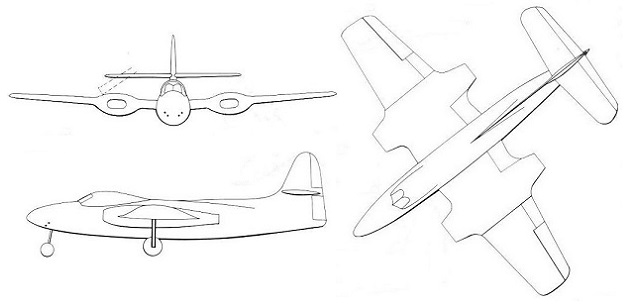
At the time, the XF9F-1 was in competition with other night fighter designs from Douglas, Curtis and Fleetwings. The US Navy deemed the Douglas proposal as being the best design (which later became the F3D Skyknight) and decided to cancel the XF9F-1 contract. While work was being done on the XF9F-1, another Grumman design team was working on designs for a single engine naval jet fighter to be powered by the British Rolls-Royce Nene turbojet engine. Instead of canceling the XF9F-1 contract, Grumman convinced the US Navy to revise the existing contract to accommodate the new aircraft design instead of cancelling the contract outright. On 9 October 1946, the contract was amended for three single engine prototypes designated as the XF9F-2. The first flight of the prototype occurred on 24 November 1947. With no major changes being required, the F9F-2 Panther went into production. The first production F9F-2 made its maiden flight on 24 November 1948 exactly year later.
Panthers move down the Grumman assembly line, Bethpage, long Island, NY, mid-1949.

Panther Variants

F9F-2
The Panther was designed around the Rolls-Royce RB.41 Nene turbojet engine but the engines that went into production F9F-2s were not British built. They were licensed built in the USA by Pratt & Whitney and was designated the J42-P-6. It produced 5,000 pounds of thrust dry and 5,700 pounds of thrust wet but it had no afterburner. Access to the engine on all Panthers was achieved by removing the tail section of the aircraft which exposed the whole engine and exhaust tail pipe. Another benefit of the Rolls-Royce Nene engine design was it did not leave any tell-tale smoke trail for the enemy to spot. The US F-80, F-84 and F-86 jet fighters however left very long trails of black smoke which made positive identification very easy for enemy pilots. Although, the British did sold the Nene engine to the Soviets who in turn reverse engineered a more powerful copy which powered the MiG-15.
The F9F-2 had an empty weight of 9,303 pounds and a maximum gross weight of 19,500 pounds. An internal fuel load of 923 gallons was carried and provided a range in excess of 1,100 miles. Top speed was around 525 mph and it could climb to 10,000 feet in less than 70 seconds. To aid in carrier landings, the Panther had leading edge flaps on the wings which were a new feature at the time. These devices helped lower the landing speed of the aircraft.
Originally, the Panther was not equipped with wing tip fuel tanks but they were soon fitted. These tanks gave the Panther a mission time of just over 2 1/2 hours radius and permitted a radius of action needed so that the flight deck crews had time to re-spot the plane on the deck between launching. The tanks were usually empty after the initial climb to the Panther’s 40,000 foot cruising altitude. Besides adding 120 gallons to the fuel capacity, they also improved the aileron response when empty. Although these tanks were detachable, they could not be jettisoned in flight. Valves at the tail end of the tanks allowed for quick venting of the fuel to lighten the load while in flight. Once fitted, Panthers were rarely seen without these tanks.
Armament for all Panthers was four 20mm (0.79 in) M3 Cannons mounted in the lower nose. These cannons carried a total of 760 rounds stored in four ammunition boxes connected to each cannon by feed chutes.
The nose section of the Panther could be slide forward on rails or removed entirely allowing access to the cannons and other equipment. This arrangement was easier compared to the USAF jets at the time which required unscrewing and removing panels to access the guns.
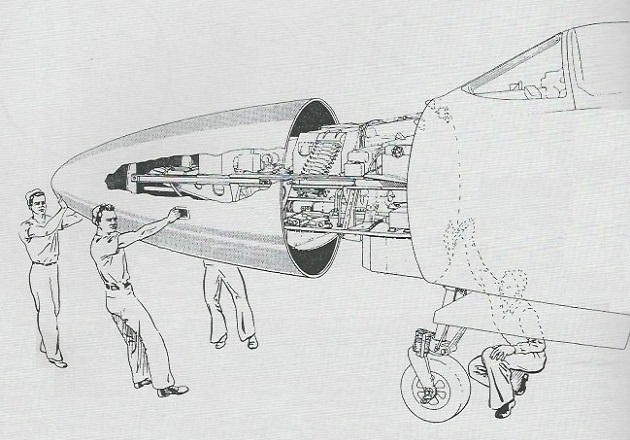
Left side view with the nose section completely removed.

Total F9F-2s built: 567
Bureau Numbers (BuNo):
122563, 122567, 125669, 122570, 122572, 122586 to 122589
123016 to 123019, 123044 to 123067, 123077 to 123086
123397 to 123713, 125083 to 125155, 127086 to 127215
F9F-2B
A number of production F9F-2s were modified as fighter bombers by replacing the standard rocket launcher stubs with three Aero 14A Combination Bomb Rack/Rocket Launchers pylons and one MK 51 Bomb pylon underneath each wing. The inboard pylon could carry either a 150 gallon drop tank or a 1000 lb bomb. Beginning with the 365th F9F-2 (BuNo 125083), these pylons were installed at the factory. After most of the F9F-2s had been brought up to F9F-2B standards, the “B” suffix was usually dropped.
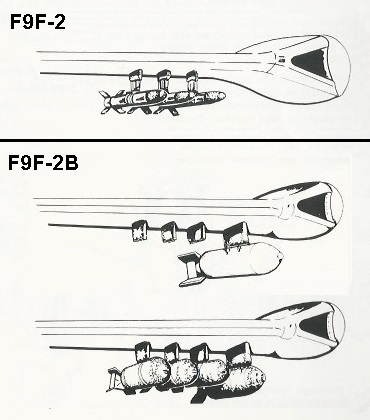
Ordnance Arrangements:
– Six Standard 5 inch HVAR rockets
– Two 1,000 lbs General Purpose (GP) Bombs
– Six 100 lbs GP Bombs and two 500 lbs GP Bombs
Maximum load of the F9F-2B: 2,800 lbs
F9F-2P
The US Navy needed a new photo reconnaissance jet which was accomplished by replacing the guns on existing F9F-2s with cameras. A view finder replaced the gun sight in the cockpit and the camera controls were located on the left console. Camera windows were added to the bottom and on each side of the nose with access to the camera bay was through a hatch on top of the nose. The nose section was the same length as the standard F9F-2. About 36 F9F-2s were converted F9F-2Ps. They usually carried tail code “PP” and were flown by VC-61 which was assigned to carriers as various detachments. The unarmed F9F-2Ps required to be escorted to and from the target areas by gun armed panthers from the carrier’s fighter squadrons.
F9F-3
The F9F-3 was externally identical to the F9F-2 but it had an Allison J33-A-8 engine which only produced 4,600 pounds of thrust. The US Navy wanted an alternate engine for the Panther in case there were any production problems with the British licensed built engine. Due to the less powerful engine, the F9F-3 was not capable of carrying any under wing ordnance. Most of the F9F-3s were eventually refitted with the Pratt & Whitney J42-P-8 engine and re-designated as F9F-2s but the assigned aircraft BuNo was left unchanged.
Total F9F-3s built: 54
Bureau Numbers:
122560 to 122562, 122564 to 122566, 122568 to 122571
122573 to 122585, 123020 to 123043, 123068 to 123076
F9F-4
The F9F-4 was the most unsuccessful of the Panther series but could had been the most capable performer. It had an Allison J33-A-16 engine which produced 6,950 pounds of thrust (using water injection) that delivered an increase in performance. The air frame had a taller tail, lengthened fuselage and revised air intakes. It could carry an external load of 4,000 lbs which was considerably more than what the F9F-2/3 could carry. But problems with the Allison engine resulted in many of the F9F-4s to be re-engine with the J48-P-6/8 engine which was used in the F9F-5. This situation was similar to the F9F-3 where the back-up or alternate engine gave more problems than the British designed engine. Most of the F9F-4s were assigned to USMC squadrons and some operated in Korea from land bases.
Total F9F-4s built: 109
Bureau Numbers: 125081, 125156 to 125227, 125913 to 125948
F9F-5
The F9F-5 was the last Panther variant with straight wings before it was upgraded to the swept wing F9F-6 Cougar. It was powered by an upgraded Pratt & Whitney J48-P-6 or -8 engine which was based on the British Tay engine. It had 7,000 pounds of thrust with water/alcohol injection and 6,250 pounds of maximum dry thrust and had a top speed of 604 MPH at sea level at combat weight. Rate of climb was about 6,000 feet per minute and had a range of 1,300 miles and a ceiling of 42,800 feet.
The F9F-4/5 were second generation Panthers which included notable physical changes. The vertical tail was taller and was more pointed at the tip which earned the nickname “Tall Tail’. The tail change was an attempt to solve a directional stability problem that plagued the Panther. The fuselage was lengthened just ahead of the wing root in order to provide more fuel for the J48 engine which had a higher fuel consumption rate and also contributed for the need of a taller tail. The air intakes were reshaped coming to a point at the outboard point where the leading edge of the wing began. A small wing fence was added just outboard of the intake openings and the fence was subsequently added to older Panthers still in service. The main armament remained as four 20mm cannons with 190 rounds per cannon.
Ordnance Arrangements:
– Six Standard 5 inch HVAR rockets
– Two 1,000 lbs GP Bombs
– Six 500 lbs GP Bombs
– Eight 100 or 250 lbs GP Bombs
Total F9F-5s built: 616
Bureau Numbers:
125080 to 125082, 125228 to 125313, 125447 to 125476
125489 to 125499. 125533 to 125648, 125893 to 125912
125949 to 126256, 126627 to 126672
F9F-5P
With the successful F9F-2P conversions, the US Navy ordered the F9F-5P to be built by Grumman. These aircraft were the standard -5 but also had a General Electric G-3 autopilot installed for use when the cameras were rolling. Unlike the F9F-2P, the nose was lengthened about 12 inches to accommodate the cameras. The cameras could perform photographic mapping as well as the usual photographic reconnaissance mission. No rocket racks were carried on the -5P, but it had the inboard pylons which could carry two 150 gallon fuel tanks to extend the range. The unarmed F9F-5Ps also carried tail code “PP” and were flown by VC-61 assigned to carriers as various detachments. It also required armed escorts to and from the target areas.
Total F9F-5Ps built: 36
Bureau Numbers: 125314 to 125321, 126265 to 126290, 127471 to 127472
Total Production of Panthers: 1382
INTO US NAVY SERVICE
Although the F9F-2 got into the air before the F9F-3, it was the F9F-3 which first entered squadron service with VF-51 “Screaming Eagles” (west coast squadron) on 8 May 1949. VF-111 “Sun Downers” was the first east coast squadron to receive the F9F-3.
VF-51 Panthers aboard the USS Boxer (CV-21) for squadron carrier qualifications along the California coast, 13 September 1949.

KOREA
At 0400 hours, Sunday, 25 June 1950, the North Korean Army supported by a brigade of Soviet built T-34/85 tanks crossed the 38th Parallel and invaded South Korea. Supporting the invasion, the North Korean Air Force was equipped with WWII vintage Soviet prop-driven planes which included 93 IL-10 Stormovik attack planes and 79 Yak fighters. At the time, the South Korean Air Force only had 8 L-4 and 5 L-5 Utility aircraft and 3 T-6 Texan trainers. The US Air Force (USAF) responded immediately by sending F-82 Twin Mustangs and F-80C Shooting Stars based in Japan and Okinawa to provide air cover for evacuation and to fly combat air patrols (CAP) over Inchon and the Kimpo/Seoul area.
The only US carrier in the far east at the time was the USS Valley Forge (CV-45) which was on a peace time deployment (began on May 1st) and was more than a thousand miles away anchored in Hong Kong harbor with its crew enjoying shore leave. Hours after the communist invasion began, the Valley Forge weighed anchor and steamed for Subic Bay in the Philippines in order to make the ship ready for combat. After a quick turnaround at Subic Bay, CV-45 steamed west and arrived off the west coast of Korea on July 1 where it joined the British carrier HMS Triumph and became part of Task Force (TF) 77.

USS Valley Forge (CV-45) with Carrier Air Group 5 (CVG-5)
VF-51 – F9F-3 Panthers
VF-52 – F9F-3 Panthers
VF-53 – F4U-4B Corsairs
VF-54 – F4U-4B Corsairs
VA-55 – AD-4 Skyraiders
FIRST NAVAL JET KILL
F9F-3 BuNo.123071, modex S109, Lt(jg) Leonard H. Plog, VF-51, 3 July 1950
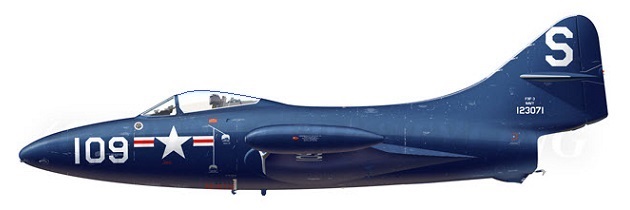

It was the first takeoff and mission of the US Navy in the Korean War and the launch was around 0730 hours. The mission was a fighter sweep over the airfield at Pyongyang, North Korea with the objective of seek and destroy all enemy aircraft in the area. Intelligence had briefed the pilots that there were more than a hundred Soviet built fighters were in the area. Plog and his wing man Ensign Eldon W. Brown rendezvoused with the main strike force of F4U-4B Corsairs and AD-4 Skyraiders and proceeded to the target area. As they circled the field, many of the enemy aircraft began taking off like wasps defending their nest. They were finally cleared to strafe targets of opportunity. Just as Plog was beginning his strafing run, he spotted a Yak fighter heading for the runway. The Yak was ahead and to the right of Plog and was starting his takeoff roll. Plog banked over to his right and pulled up behind him. By the time Plog got into firing position, the Yak was airborne about 350 feet in the air. As Plog was closing in on the Yak, he looked to his left and saw another Yak shooting at him. The other Yak had a perfect run on Plog’s panther but Plog had pulled up as it was firing and it missed him. At that second, Brown pulled in behind the Yak and opened fire. Sections of the Yak’s starboard wing separated and the Yak rolled to the right and crashed into the ground. All that occurred in an instant and then Plog looked back at his Yak. He was in a perfect position and fired a short burst of his four 20mm cannons. He got several lucky hits on the Yak’s starboard (right) wing as it peeled away. The Yak flipped over and then crashed into the ground. Plog and Brown made several more passes over the field, shooting up trucks, the control tower and a power sub-station. There was a large fireball and explosion when they hit a small fuel dump. When they were low on fuel, they turned and headed back to the carrier landing back aboard the “Happy Valley” around 0900 hours.
Lt(jg) Plog in a public relations photo with a kill marking flag painted on his panther.

In many books and publications, the VF-51 Squadron marking was mistakenly identified as a kill marking and incorrect Panther photos and artwork were captioned as being Plog’s Yak killer.

A destroyed North Korean Yakovlev Yak-9P.

FIRST JET VS JET KILL
On 1 November 1950, MiG-15 jet fighters appeared for the first time in the Korean war and engaged a USAF T-6 Texan and F-51D Mustangs in the Yalu River area. On 8 November 1950, USAF 1st Lt. Russell J. Brown of the 16th Fighter Interceptor Squadron (FIS), 51st Fighter Interceptor Wing (FIW) was flying Lockheed F-80C-10-LO Shooting Star (s/n 49-713) during an attack on the Sinuiju bridges near the mouth of the Yalu River. Six MiG-15s bounced the flight of F-80s. The US pilots turned into their attackers and split them up chasing five of them back across the Yalu. The last MiG broke in the wrong direction and appeared below Brown’s F-80. Brown decided to go for it, threw his stick forward and went into a dive behind his prey with the MiG in his gun sight. With only one of his six .50 caliber guns working, some of Brown’s rounds scored hits on the diving MiG fuselage. The MiG falling apart and trailing thick black smoke dived straight into the ground causing a large explosion. Eyewitness reports from Brown’s fight mates and his gun camera footage verified the kill. The glory of the USAF first MiG kill almost immediately faded into obscurity. After the collapse of the Soviet Union in 1991 and access to Soviet records, it is strongly indicated that the Soviets did not lose a MiG-15 that day. Russian pilot, Senior Lt. Vladimir Kharitonow of the 72nd Guards Fighter Aviation Unit flew the MiG-15 that was shot up by Brown’s F-80 on that day but he did not crashed. Kharitonow dived to escape and at the last second jettisoned his external fuel tanks which exploded on impact with the ground. He then pulled up and managed to nurse his damaged MiG back across the Yalu and landed. US veterans claims that the MiGs did not carry external fuel tanks and there were no need to. The Soviet records showed that Brown’s claim was a honest mistake but the USAF still credited 1st Lt. Brown with the aerial kill.
F9F-2B, Lt. Cdr William T. Amen, CO of VF-111 “Sun Downers”, USS Phillipine Sea (CV-47), 9 November 1950
A combined strike against the Sinuiju Bridge was carried out by a group of USN F4U Corsairs and AD Skyraiders. Leading a division of four Panthers, Amen’s flight was escorting F4Us and ADs bombing the bridge and power plants. Armed with 20mm and fragmentation bombs, the Panthers were providing flak suppression to keep the enemy gunner heads down. Suddenly, they were attacked by MiG-15s who flew right into the Panthers formation so close that the Panther pilots were able to see that the MiG pilots were wearing leather helmets. During the ensuing dogfight, Amen and his wing man George Holloman latched onto the tail of a MiG-15 and started firing 20mm at the MiG. It was difficult for the Panthers to keep up with the MiG and stay in firing range of the MiG. All of a sudden, the MiG twisted from its straight course, and trailing smoke and flame nosed over into a dive that went right into the ground. The MiG-15 crashed within sight of the Yalu River, the border between North Korea and china.
Upon return to the USS Phillipine Sea, Amen climbs out of the F9F-2B Panther which he scored his victory against the MiG-15.

During that flight that day, Lt. Cdr Amen was not flying his usual Panther but instead was flying a borrowed F9F-2B from VF-112, their sister squadron which was also on board the USS Philippine Sea. Maintenance schedules or positioning on the flight deck sometimes require pilots to fly any plane that were available at the time. While VF-111 received the credit for the kill, the VF-112 Panther had the MiG-15 kill marking painted on their plane.
This artwork depicts the F9F-2B which Amen flew during the engagement. It displays an incorrect BuNo 124709. BuNo 124709 was for a Vought F4U-5NL Corsair and the correct BuNo was 127094.
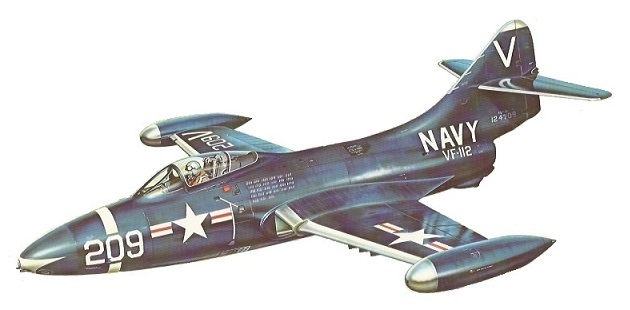
Captain Mikhail Fedorovich Grachev of the 139th Guards Fighter Aviation Regiment (GvIAP) was the CO of the 1st squadron of MiG-15 fighters based at Liaoyang airfield. Soviet records indicate that Grachev was flying MiG-15 120125 built at Factory No 1 was shot down by Lt. Cdr Amen on 9 November 1950. Grachev was the first Soviet pilot killed in Korea and his MiG-15 was the first to be lost in combat.
Captain Grachev’s MiG-15 markings in November 1950. In January 1951, the Soviet MiGs began to carry North Korean markings.

Lt. Cdr Amen usually flew F9F-2B BuNo 127184. Later this Panther was sold to the Argentine Navy (See below).

PANTHER’S NOSE PROBLEMS
During early combat action in Korea, the US Navy reported that some Panthers sliding nose were blown off inflight during high altitude gun firing. This was caused by gases emanating from the four 20mm cannons in the nose compartment were building up and exploded for some unknown reason.
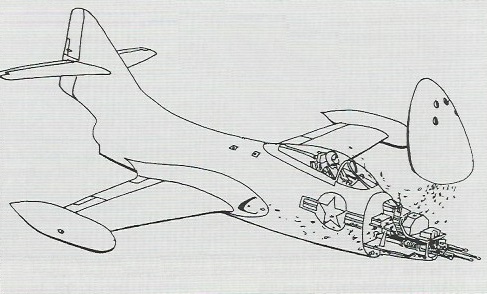
After further testing, two gun gas vents were installed on both sides of the nose skins. The vents effectively removed all the gun firing gases. On the left edge of the photo just below the “5” is the standard Air intake on the nose section.

There were a number of instances where Panthers lost their nose covers upon landing aboard the carrier. The Panther’s arrestor hook caught the wire bringing the Panther to an abrupt stop but the nose section was ripped off its rails and went bouncing down the flight deck.
VF-781 F9F-2B (tail code D) lands aboard the USS Bon Homme Richard (CV-31) in 1951.

VF-91 F9F-2 lands aboard the USS Philippine Sea (CVA-47) in 1953.
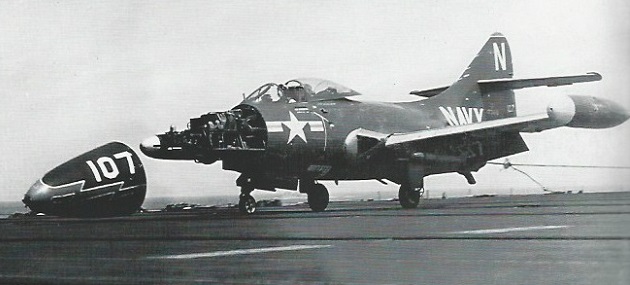
F9F-2B BuNo.125122 S116, Neil Armstrong, VF-51, 1951

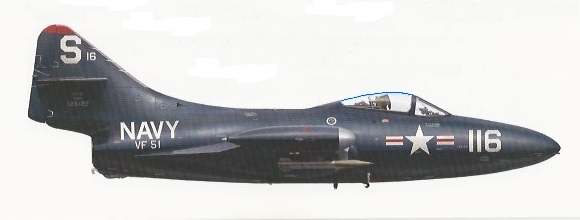
Eighteen years before he step foot on the moon, Ensign Neil Armstrong served with the VF-51 squadron aboard USS Essex (CV-9). On 3 September 1951, only 5 days after his first combat mission in Korea, Armstrong was shot down in F9F-2B 125122. He was flying an armed reconnaissance sortie over transportation and storage facilities south of the village of Majon-ni, west of Wonsan when his panther was hit by ground fire while making a low strafing run at about 350 mph. While trying to regain control, he collided with a 20 foot telegraph pole. Some source state his plane collided with a cable strung between two mountains to snag low-flying aircraft. Several feet of his Panther’s starboard (right) wing was tore off. Armstrong was able to nurse his stricken aircraft back south along the coast over friendly territory but due to the loss of the right aileron he was forced to eject. Planning to eject over water and await rescue by USN helicopters, he flew pass an airfield near Pohang and he ejected. While floating down in his parachute, the wind had blown him back over land and after landing he was picked up by a jeep from the nearby airfield. A Navy TBM Avenger transported him back to the Essex and he was on the flight schedule the next day.

F9F-5 BuNo.125459 D106, Lt. Royce Williams, VF-781, USS Oriskany (CV-34), 18 November 1952

On 18 November 1952, the weather was 500 feet overcast and visibility was obscured with blowing snow. Radar approach and departures were required for all operations. Royce flying off the Oriskany launched with a flight of four Panthers as part of a three carrier strike group to strike North Korean industrial targets near the border with the USSR. Multiple bombing runs were successfully made under the overcast without significant AAA fire and all strike aircraft returned safely to the carriers and were recovered.
Royce was scheduled for a second launch as second section leader in a four plane Combat Air Patrol (CAP) mission which were to protect the Oriskany if any hostile aircraft approached the carrier. The four Panthers launched at 1300 hours and climbed through the overcast until breaking out into clear skies at 12,000 feet. The radar controller radioed the flight that bogies (unidentified aircraft) were 83 miles north flying on a course directly towards the Carrier Task Force (CTF). The CAP was ordered to proceed directly toward and intercept the inbound aircraft. While passing 16,000 feet, Royce spotted approaching contrails and then seven MiG-15s flying abreast of each other above 35,000 feet.
Lt. Elwood, the Flight Leader reported a problem with his fuel pump and the CTF ordered him to abort the mission. Lt. Elwood passed the lead to Royce and turned back to the CTF with his wing man Lt(jg) Middleton flying as escort. Now it was 7 against 2. Royce and his wing man Lt(jg) Dave Rowland continued climbing toward the approaching MiGs. At 45 miles from the CTF, the MiGs passed directly overhead and immediately turned left as though they were going to make a 180 degree turn and withdraw. Royce turned left to follow the MIGs and continued his climb to 26,000 feet. Royce followed the seven MIGs keeping them in sight. The MIGs abruptly broke sharply back toward the two Panthers, split into two groups of 4 and 3 aircraft and dived steeply. Royce lost the MiGs when they passed conning altitude and their vapor trails vanished. Royce reported to the Oriskany controller that he lost contact and requested information on the bogie locations but the bogie blips were no longer visible on ship’s radar.
Royce started a gradual left turn after arriving at the position of last visual contact. A line of four MiGs abreast suddenly appeared at ten o’clock, diving at them with all guns firing as they attempted to shoot down the Panthers. Royce turned into the four MiGs and positioned his Panther in gun range on tail end Charlie. Royce fired a short burst of 20mm cannon fire at the trailing MiG. His 20mm shells hit the fuselage of the MiG and it fell out of the formation trailing smoke and aircraft parts.
Royce’s wing man followed the smoking MiG down to 8,000 feet trying to get his guns to fire and his gun camera to function. He finally gave up, broke off the engagement and started the long climb back to his Section Leader. The remaining three MiGs climbed to a position for another firing run on Royce. Then they reversed course, rolled in on individual diving runs and commenced firing both 23mm cannons and the 37mm gun from a distance away. Royce turned into them again and fired his 20mm as they flashed by at a very high rate of closure. The other three MiGs joined the fray which had Royce alone dog-fighting six MiGs. While reversing, jinking and rolling against the MiG gaggle, Royce sees a MiG locked on his six o’clock position but Royce executed a very hard turn which caused the MiG to overshoot. Royce was firing at every MiG that passed within gun range as they sped by after taking shots at his tail. Finally, Royce got in a kill position on another MiG and fired off a concentrated burst while watching the rounds hit on the MiG’s fuselage. The disintegrating MiG forced Royce to break away from the debris. Several times Royce tracked an individual MiG and fired rounds that appeared to hit the target. Royce did not follow the damaged MiGs but instead kept trying to keep his 6 o’clock clear of MiGs while still firing at every opportunity. Royce was tracking and firing at a smoking MiG when he saw a MiG slip into close range on his six. Royce rapidly reversed by breaking sharply but he felt a 37mm shell hit him which severely damaged his Panther. He lost rudder control and had little use of his ailerons which left him with only one fully operational flight control and that was his elevators. By porpoising his Panther, he could see 23mm tracers passing above and below and could even see the 37mm projectiles as they flew by his damaged Panther. Royce pushed hard over and while still at full throttle made for the 12,000 foot cloud tops.
Royce broke out below the clouds and headed back to the Oriskany. As he passed over a few ships of the CTF, some fired at his aircraft. The friendly fire stopped once his Panther jet was visually recognized. Royce flew aboard the carrier with a lot of help from the Captain of the Oriskany lining the ship on final approach to accommodate the damaged Panther. Once back on board, his Panther was examined by the crews. It received 263 hits by cannon shells or fragments. It was declared beyond repair, stripped of usable parts, and was eventually pushed over the side.
Lt. Royce Williams got at least 3 of the MIGs in this engagement while expending all his 20mm ammunition, 760 rounds. The Soviets actually lost four of the MiG-15 aircraft on the flight to CTF-77 but verification of each downed MiG by Royce could not be firmly substantiated since the fourth MiG could have been lost to maintenance problems and not to Panther cannon fire.
Royce was warned not to tell anyone about his Soviet MiGs encounter.
Royce points to the hole made by a Soviet 37mm cannon shell.

Side view of Williams’ Panther on the flight deck. On top of the fuselage are the covers over the auxiliary air intake blow-in doors. Note the large hole in the side of the fuselage in the engine accessory section of the Panther.

A frame from Williams’ gun camera film showing one of the MiG-15s trailing smoke.
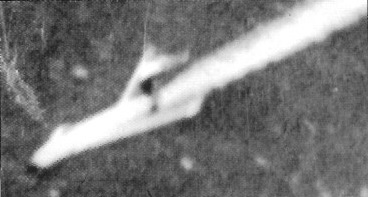
Video: US Pilot Dogfights 7 MiGs – Korea 1952
According to Soviet records:

A US Navy carrier task force consisting of the USS Oriskany (CVA-34) and the USS Princeton (CV-37) approached the North Korean coast near the North Korean port of Najin and executed a dawn airstrike against an industrial complex at Hoeryong. In response, FOUR MiG-15s of 781st IAP, Pacific Ocean Fleet 165th IAD commanded bCaptain N. M. Beliakov took off from the Soviet Unashi border airfield in the Primorsky District, south of Vladivostok, and patrolled over the area where the US carriers were located. Near the US task force and over international waters, the MiG-15 flight were unexpectedly bounced by a division of F9F-5 Panthers of VF-781 from the USS Oriskany. The Panther’s broke up the MiG flight formation and damaged Senior Lieutenant Vladimir Ivanovich Pakhomkin’s MiG. Both Pakhomkin and his element Leader Senior Lieutenant B. V. Pushkarev broke off from the attack with a sharp turn and exited the combat area. Pakhomkin’s MiG was not able to reach the coastline due to a leaking fuel tank which was hit during the attack, crashed into the sea near Cape Lev where he drowned. Captain Nikolai Mikhailovich Beliakov and his wing man Senior Lieutenant Aleksandr Ivanovich Vandaev were not able to escape from the groups of Panthers (four more VF-721 Panthers and four VF-11 F2H-2 Banshees from the USS Kearsarge had arrived on the scene); fighting heroically they were both KIA. Only Pushkarev’s MiG managed to return back to Unashi airfield.
Both sides exchanged protests of what happened. All records connected with the whole instance on both sides were classified and long forgotten. This engagement could had caused a serious international incident which could had escalated the Korean “police action” into a possible global war with the USSR.
F9F-5 BuNo.126109 WL10 of Captain Ted Williams, VMF-311, 16 February 1953

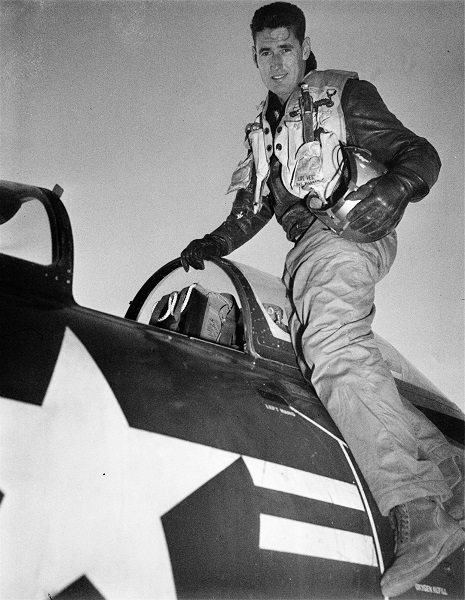
Theodore Samuel Williams was an American Major League baseball player. He played as a left fielder for the Boston Red Soxs from 1939 to 1960. Williams spent three baseball seasons during WWII, earning his Naval aviators wings and then was an instructor pilot at Pensacola Naval Air Station (NAS) in Florida for the Vought F4U Corsair. While awaiting assignment as a replacement pilot, the war in the Pacific ended before Williams had the chance to see combat. After WWII, Williams was in the USMC Reserves and was later recalled to active duly in Korea. Then being married and had a family, Williams was not pleased with the recall. After refresh training on the Panther, Williams joined VMF-311, the “Willy Lovers” which was the phonetic pronunciation of their “WL” tail code. In 1957, the squadron’s nickname was changed to the “Tomcats” when the squadron transitioned to the swept wing F9F-8 Cougar.
On 16 February 1953, 16 VMF-311 and 19 VMF-115 Panthers attacked an enemy supply concentration along Highway 1 near Pyongyang. Only one Panther was hit during the strike and it was piloted by Williams who was on his first combat mission. His aircraft was hit when he pulled up and did not feel the impact. He discovered the problem when he approached 5,000 feet and his stick started to shake violently. He contacted his flight leader who came to his aid guiding him back to Suwon Air Base (K-13). He arrived over the field with zero fuel and a loud rumble coming from the rear fuselage. With no flaps and no landing gear, he was forced to make a belly landing. He hit hard and skidded along the tarmac for almost a mile with sparks flying and barely missing a fire truck. He skidded to a stop where his plane burst into flames. Williams opened his canopy, struggled out and walked away. Williams flew his second combat mission the next day.

He flew 37 combat missions and several missions were flown with John Glenn. Among the decorations, he received the Air Medal with two Gold Stars for meritorious achievement. Williams returned to the States and was released from active duty on 28 July 1953.
F9F-2B BuNo.123602, Major John H. Glenn Jr., VMF-311, March 1953
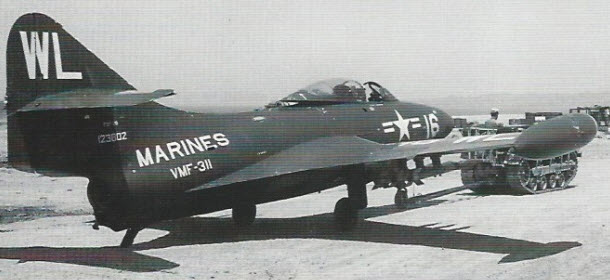
It was during his 63 missions with VMF-311 over Korea that he gained a fitting nickname “Old Magnet Ass.” He earned the name as a result of the way he aggressively pursued ground targets in his Panther. He would dive in for attack runs long after the element of surprise had been lost and in the process would attract so much AAA fire that his jet would come back riddled full of holes.
On a mission near Sinanju on the Yalu River, he spotted an enemy AAA pillbox. After he positively identified the position, he circled back and made an attack run. He dove down and opened fire at close range with his Panther’s 20mm cannons while the enemy gunners returned fire. He destroyed the AAA emplacement but his jet was heavily damaged and barely controllable. Amazingly he made it back to home base at K-3 airfield and was able to land the jet without crashing it. The Panther’s tail had a massive hole in it and about 250 or so smaller holes were found on the aircraft. After the Panther’s tail was replaced with a completely new tail and all the holes were patched, the jet returned to action.
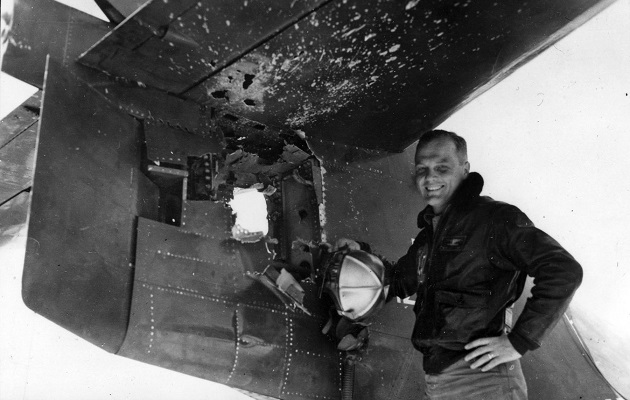
A week later, Glenn’s Panther was hit again but that time an AAA shell had detonated a napalm canister under his wing. Again, he was able to bring the burnt and badly damaged jet back to base but that time the aircraft could not be repaired — it was literally burnt to a crisp.
After his tour with VMF-311, he served as an exchange officer with the USAF 25th Fighter Interceptor Squadron, 51st Fighter Interceptor Wing at K-13 and flown 27 missions. In July 1953, Glenn shot down three MiG-15s flying a North American F-86F-30-NA Sabre (s/n 52-4584) Sabre named “MiG Mad Marine”. After Korea, he became an elite US Navy test pilot and later the first American to orbit the earth.
USMC Panthers were often armed with Tiny Tim 11.75 in (29.8 cm) rockets. These rockets were first used by the US Navy and the USMC at the end of WWII and were effective against coastal guns, bridges, pillboxes, tanks, and shipping. F9F-2 BuNo 125116 of VMF-311 is shown with a Tiny Tim rocket mounted. Later this Panther was sold to the Argentine Navy (See below).

It was rare that a US Navy or USMC Panther to have any nose art added. F9F-2 BuNo 127207 of VMF-311 at Pohang (K-3) in August 1952 had this unique panther head and claws motif on the nose.

F9F-2 BuNo 127180, number 115, assigned to Ensign George Clare of VF-71 (“Fickle Finger Squadron”, tail code L) of CVG-7 on the USS Bon Homme Richard (CV-31) in 1952. Note the name “BLPFSTK” with a rain cloud over it.

The name is probably for the comic strip character from Al Capp’s “Li’l Abner (published 1934–1977), Joe BTFSPLK. He was “the world’s worst jinx”. That would explain the rain cloud but the name was spelled incorrectly. The small rain cloud hovering over his head symbolized his bad luck. Al Capp pronounced his name by closing his lips, leaving his tongue sticking out, and then blow out air, which is usually called a “raspberry” or a Bronx cheer. This is a 20 March 1947 comic strip.

During the Korean war, a Navy tradition began that there was a penalty when a pilot mistakenly lands their plane on the wrong carrier. The traditional penalty was as custom paint job on the disoriented plane as a “tribute to pay” so the pilot would not forget his error.
Three F9F-5s of VF-111 are seen on board the USS Philippine Sea (CVA-47) on 31 March 1953. The third Korean war deployment of VF-111 was on the USS Boxer (CVA-21) which began on 30 March 1953. The squadron was cross-decked to the USS Lake Champlain (CVA-39) on 30 June 1953. Over 80 mission marks can be seen on the side of 127191 in the foreground and on 127173 to the right. The marked up fuselage and right wing of the third unidentified panther can be seen in the background.

The pilot had to face the embarrassment when they returned to their assigned carrier. F9F-5 Panther “Dopey” of VF-111 in early 1953.

Film: US Navy F9F aircraft of CVG-5, Squadrons VF-51 and VF-52
Film: US Grumman F9F Panther Jet aircraft flies over water and lands
Film: Planes Dispatch To Korea
Film: US Navy jet aircraft F9F Panther towed by tractor on flight deck
Film: F4U Corsair and F9F Panther Operations USS Leyte (1950)
Film: F9F Panther Napalm Strike Korean War
Film: Grumman F9F Panther Vs MiG-15
Film: USS Valley Forge recovers F4U and F9F aircraft
Film: US Navy jet fighter aircraft F2H Banshee and F9F Panther
Film: Plane Crash – Ramp Strike vol.2
BLUE ANGELS
The US Navy Blue Angels transitioned to jet planes in 1949 converting from the Grumman F8F Bearcat to the F9F-2 Panther in 1950. The team was recalled to combat duty during the Korean War, but shortly afterwards the team was reformed as a flight demonstration team. The second jet the Blue Angels transitioned to was the swept wing F9F-6 Cougar in August of 1953. However, problems developed forcing them to revert back to the F9F-5 Panther until December 1954.

Film: Blue Angels F9F Panther, NAS Pensacola, 8/2/1950
Note: There is a scene where a crewman is slid into the wing root intake for inspection.
ARGENTINA NAVY
The only foreign buyer of the Panther was Argentina’s Servicio de Aviacion Naval. In 1955, formal negotiations were conducted for the purchase of Grumman F9F Panthers from the USA. The deal was finalized at the end of 1955 but Argentina received no aircraft until August 1958. The purchase price was $10,716,000 USD for 24 F9F-2s, spares and limited training. In 1957, the aircraft which had been stored at NAS Corpus Christie, were inspected and trucked to NAS Pensacola, Florida where they were loaded onto the ARA Navy transport “Bahía Buen Suceso” (B-6). They arrived in Argentina in August 1958 and were transported over land to Base Aeronaval Puerto Belgrano where the aircraft were refurblished and prepared for active service. Work started on 8 aircraft and the first (0416 / 2-A-20) was completed on 1 December 1958. On 4 December 1958 the same day No. 1 Squadron was established, Captain Baldacci made the first flight of an Argentine Panther. During 1959, six additional Panthers were completed and they were identified as 2-A-101 through 2-A-107. The eighth Panther 0423/3-A-108 did not enter service until 22 July 1960. Additional Panthers were refurblished and added to the operational pool until the last one was completed in 1963. They were strictly land-based aircraft, since the catapults on the then only Argentine carrier, ARA (V-1) Independencia was not considered to be powerful enough to launch the F9F-2. The Panthers were assigned to the 1a Escuadrilla Aeronaval de Ataque as part of the 2a Escuadra Aeronaval based at BAN Commandante Espora in Puerto Belgrano.
Argentine Panthers on the flight line. The pilots are wearing orange flight suits with the yellow life vests.

Argentine Panthers were painted gull grey with white undersides and carried red lightninig flashes on the wing tip tanks. The blue and white national flag with a yellow sun at its center was painted on both sides of the forward fuselage. All the other markings were black.

The squadron commander’s Panther carried a sky-blue and white pennant on the starboard side of the nose.

This is a close of number 103 showing the command pennant just behind the nose number.
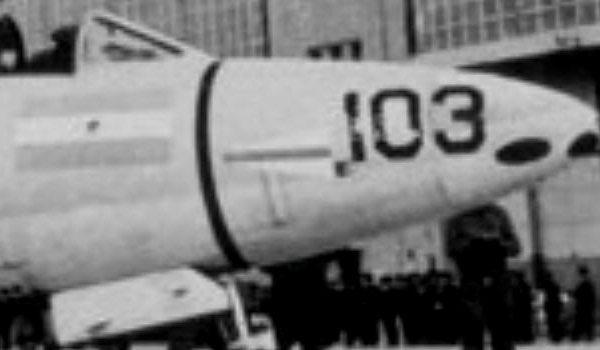
Many of the Panthers were equipped with the AN/ARA-25 antenna in a chin radome. Note the positions of the wing anchors on Panther 3-A-118 which were painted on both sides of the wings.
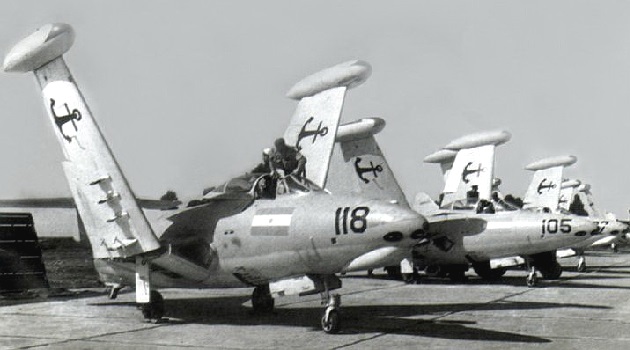
Number 113 in flight. The strips on the wing along the fuselage are maintenance walkways. Many aircraft had those painted a contrasting color to clearly show where you could safely walk without damaging the aircraft. The walkway paint often included a rubberizing or roughening additive to provide a non-slip surface.
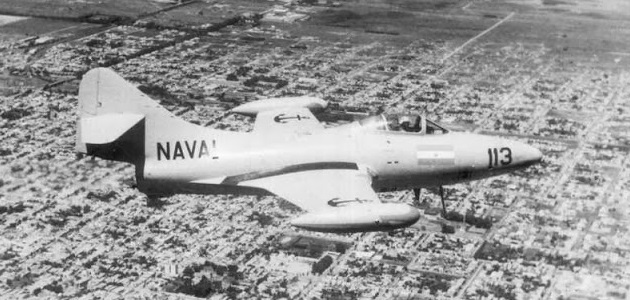
Panther 3-A-110 with HVAR rockets and MK-47 napalm bombs.

Emblem of Naval Base Spore, 1st Naval Hunting and Attack Squadron

1963 Argentine Navy Revolt
In August and September 1962, serious institutional events occurred in the country. The power struggle was confined to the confrontation between “Azules” and “Colorados” (Blues and Reds) which culminated in the 1963 Argentine Navy Revolt. On 2 April 1963, high-ranking officers from all three branches of Argentina’s military attempted a coup to prevent the election from occurring that July. The Argentine Army 8th Tank Regiment commanded by Colonel Alcides López Aufranc was mobilized to seize the rebelling Base Aeronaval Punta Indio. A Beechcraft RC-45J aircraft was damaged in flight over the regiment located in Magdalena. In retaliation and under the orders of base commander Captain Santiago Sabarots, the Army 8th Tank Regiment was attacked by Corsairs F4U-5, -5N and -5NL, SNJ-5C Texans and Panther aircraft, destroying a dozen M4 Sherman tanks. During the combat, Naval Aviation lost a Corsair and two Panthers (0424/3-A-109 and 0422/3-A-107). According to ARA sources, the Panthers collided in flight (operational accident), while sources from the Argentine Army state that they were shot down by AAA fire.
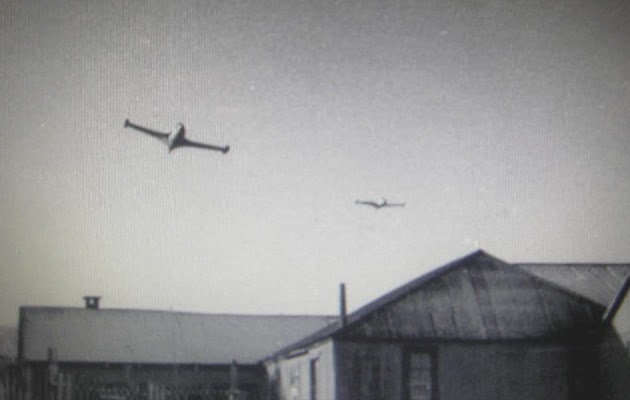
Film: Rebelion militar argentina entre Azules y Colorados 1962
Film: Argentine Naval Revolt | The “Azules” versus the “Colorados” | April 1963
At 0800 hours on April 3, the Argentine Air Force retaliated where F-86 Sabres, Gloster Meteors and MS.760s launched air strikes against the naval base destroying five naval aircraft on the ground, four were Panthers. The Army 8th Tank Regiment occupied Punta Indio and found it abandoned. Its personnel fled to Uruguay and left behind five seamen and four wounded. Afterwards, the 1a Escuadrilla Aeronaval de Ataque was transferred to 3a Escuadra Aeronaval at BAN Commandante Espora.
0447/3-A-123 (Ex. BuNo 125139) with its nose section removed and has a MK-47 napalm bomb mounted.
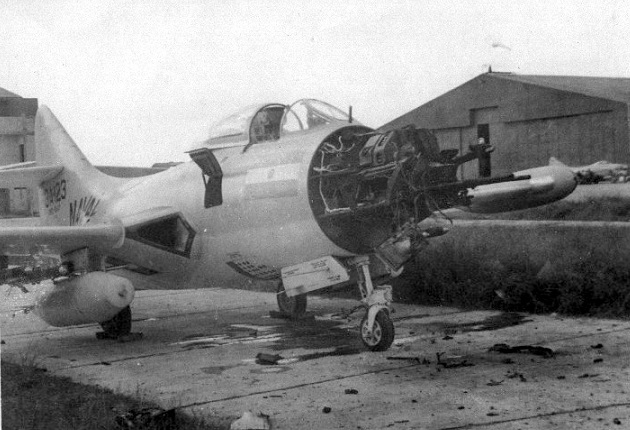
On 21 July 1963 during trials, Captain de Corbeta Martinez Archaval flying Panther 0447/3-A-119 made the first jet arrested landing aboard the ARA Independencia.

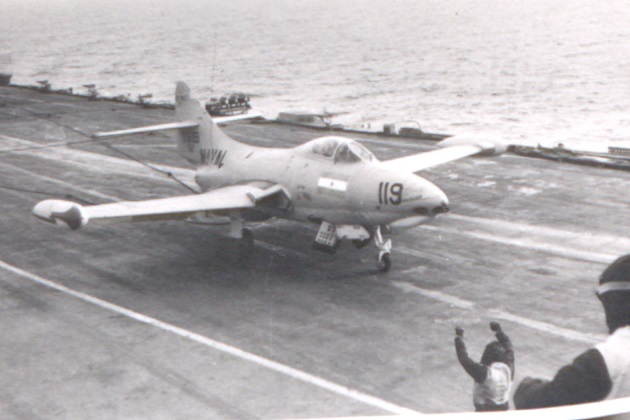
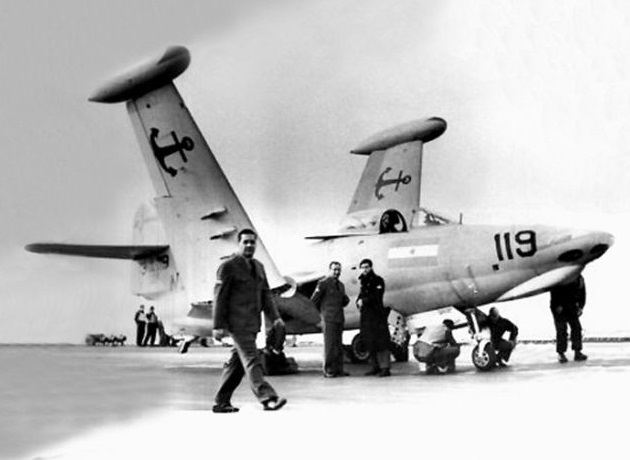
Argentine Panthers were briefly in action in 1965 when they flew patrols during a border clash between Argentina and Chile. Lack of spares forced the Argentine Navy to ground its F9F-2s in 1969.
Of the 24 F9F-2 Panthers of the Argentine Navy, seven were lost in the events of April 1963, two suffered accidents, ten were scrapped at the end of their operational careers, one sold to the United States, and four survive at the present time in Argentina. Two of them are mounted as monuments – one at the Punta Indio Naval Base and the other at the Puerto Belgrano Naval Base and one is on display in the Tigre Naval Museum and one is in the Naval Aviation Museum.
0421/3-A-106 (Ex USMC VMF-311 BuNo 125116) flying over ARA Independencia venting extra fuel from it wing tip tanks.
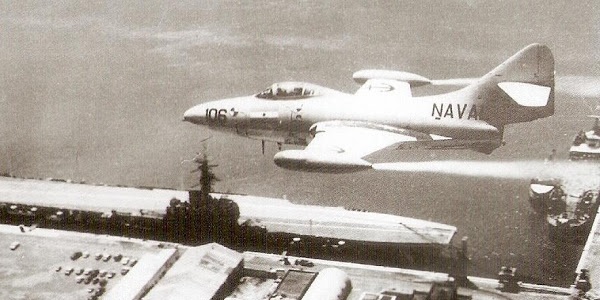
0421/3-A-106 – Gate guard at Puerto Belgrano Naval Base (Base Naval Puerto Belgrano – BNPB) at Bahía Blanca, Argentina.

ARGENTINE F9F-2 PANTHERS LIST
| US Navy BuNo | Argentine Navy Serials |
| 125149 | 0416 / 2-A-20, 2-A-101, 3-A-101 |
| 125085 | 0417 / 2-A-21, 2-A-102, 3-A-102 |
| 125135 | 0418 / 2-A-22, 2-A-103, 3-A-103 |
| 125136 | 0419 / 2-A-23, 2-A-104, 3-A-104 |
| 127139 | 0420 / 2-A-24, 2-A-105, 3-A-105 |
| 125116 | 0421 / 2-A-25, 2-A-106, 3-A-106 |
| 127092 | 0422 / 2-A-26, 2-A-107, 3-A-107 |
| 127190 | 0423 / 2-A-27, 2-A-108, 3-A-108 |
| 127187 | 0424 / 2-A-28, 2-A-109, 3-A-109 |
| 127207 | 0425 / 2-A-29, 2-A-110, 3-A-113 |
| 125093 | 0426 / 2-A-30, 2-A-111, 3-A-116 |
| 125137 | 0427 / 2-A-31, 2-A-112, 3-A-117 |
| 125139 | 0447 / 3-A-123, 3-A-119 |
| 125144 | 0448 / 3-A-115 |
| 127087 | 0449 / 3-A-124, 3-A-101 |
| 127099 | 0450 / 3-A-118 |
| 127102 | 0451 / 3-A-110 |
| 127105 | 0452 / 3-A-111 |
| 127107 | 0453 / 3-A-118 |
| 127109 | 0454 / 3-A-112 |
| 127147 | 0455 / 3-A-114 |
| 127184 | 0456 / 3-A-107 |
| 127189 | 0457 / 3-A-121 |
| 127193 | 0458 / 3-A-122 |
HOLLYWOOD MOVIES
The Bridges at Toko-Ri (1954), Paramount Pictures
Starring William Holden, Grace Kelly and Mickey Rooney
Men of the Fighting Lady (1954), Metro-Goldwyn-Mayer
Starring Van Johnson and Walter Pidgeon
Exterior scenes were shot aboard the USS Oriskany (CVA-34) and USS Kearsarge (CVA-33) ,Essex-class aircraft carriers which represented the USS Savo Island in the movie. The actual USS Savo Island (CVE-78) was a much smaller escort carrier that served in WWII and was decommissioned in December 1946. The aircraft used in the films was the F9F-5 which was still in service and equipped the air groups of both carriers at the time the film was made. However in the novel, Brubaker’s squadron flew McDonnell F2H Banshees. The squadron depicted was an actual unit, VF-192 “Golden Dragons,” which was aboard the Oriskany during the filming and took part in the movie. During the war, VF-192 had two deployments in Korea but aboard the USS Princeton (CV-37) But flew Vought F4U-4 Corsairs. The squadron also participated in filming “The Men of the Fighting Lady” on the same cruise.
Both movies are available on DVD and Blue-Ray.
LAST FLYING PANTHER
F9F-2 Panther BuNo 123072

Owner: Arthur Alan Wolk
Film: F9F Panthers at Tico Airshow 1987
Film: F9F Panther at 1993 Kalamazoo Airshow
Sadly, the Panther was damaged severely after a take-off accident in Kalamazoo, MI, 1997.
MODEL KITS AND DECALS
1/48 MODEL KITS:
Hobbycraft HC1421 F9F-2/-3 Panther ‘Korea’ – 2007
Trumpeter 02832 US. Navy F9F-2 “Panther” – 2007
Trumpeter 02834 Grumman F9F-3 Panther – 2007
Monogram 5456 F9F-5 Panther – 1991
Hasegawa 86365 F9F-5 Panther ‘Blue Tail Fly’ – 199x
1/48 DECALS:
Victory Productions VPD48008 F9F-2 Panthers – 2008
Yellowhammer Models YHD48039 F9F-2 Panther Hot Cats on Parade #2 – 2007
Aerocalcas Argentinas 48005 PANTHER F9F NAVAL
Print Scale 48-109 Decal for Grumman F9F Panther part 2 (Has Argentine 103)
1/72 MODEL KITS:
HobbyBoss 87248 F9F-2 Panther – 2011
HobbyBoss 87250 F9F-3 Panther – 2011
Revell 04286 F9F-4/5 Panther – 2009
Hasegawa 01242 F9F-2 Panther – 2008
Matchbox PK-124 F9F-4 Panther – 1985
1/72 DECALS:
Starfighter Decals 72-141 USN Panthers Part I Killer Cats Decals – 2017
(Has BuNo 127190 for Lt. Cdr Amen’s Panther which was the BuNo of V/208 also from VF-112. VF-112 V/209 correct BuNo was 127094.)
Microscale 72-206 Grumman F9 F-2 Panthers
(Has VMF-311 Panther head/claws markings)

Thanks again Mike for another great article!
LikeLike
Like!! I blog quite often and I genuinely thank you for your information. The article has truly peaked my interest.
LikeLike
– Very Nice tribute to one of the stars of the golden age of Naval Aviation; I now know what happened to the flying Panther I last saw in 1990 at the TICO Airshow (I was going thru nearby NTC in Orlando)
– Fly Navy; (Still occasionally volunteer at the Valiant AC, when in the FL)
R/
AM1(AW) C. Reus (“Older”)
LikeLike
Hi sir – where do you find the color photo (or still) of the VF-52 F9F-3 #208? Great article! Thanks.
LikeLike
Mike, this website and your research are great. Thank you for providing this!
Have you ever come across any 1950’s US Navy training documents? Anything from the FAGU, or VC-3, or Cougar College? Manuals, a syllabus, homework for pilots, course outlines or training films? I can’t find anything, maybe you’ve had better luck?
Thanks!
LikeLike
Hello Mike. Good article. I researched the recently released “Navy F9F-2 -3 Panthers in Combat over Korea”, decal sets from Print Scale which depicts Amen’s assigned F9F-2 BuNo 127184, Modex Code V-101, and seven other notable aircraft from the conflict. You can find the first set: 48-159 and the second set here: 48-160, both in 1/48th scale. The 1/72nd scale set (with all eight birds) can be viewed here: 72-372.
LikeLike
I built an f9f model kit in around 1960 and it must have been 1/48 or larger, moulded in dark blue plastic. One way or another I still treasure that elegant and tough shape and I am amazed that such a simple workman like airframe and jet engine has resulted in no flying examples left gracing the warbird circuits! How hard could it be? It’s smallish and, to me, far more straightforward than prop units from a similar era.n
LikeLike
Reblogged this on My Forgotten Hobby IV and commented:
My next build… Monogram 5456 F9F-5 Panther – 1991
LikeLike
Enjoyed Reading your Research on the Grumman F9F Panther. My Father served in VMF-311 back in 1953 I asked him after he Retired from The Marine Corps if he served as Plane Captain for John Glenn,Ted Williams? No they had already Transferred out. Semper Fi Tomcats
LikeLike
Dear Mike,
I thoroughly enjoyed reading your post on the Grumman F9F and its use during the Korean War. I came across your website while I was searching for information regarding Neil Armstrong’s F9F-2, (USS Essex, Squadron – VF-51,) that he bailed out of, after losing part of one wing. I have read elsewhere, and you confirmed that the BU# was 125122. You also stated that the Modex # was S-116.
I have seen numerous actual photos of #S-116 and they show its BU# as 125127.
Has any of your research found the actual Modex # for BU-125122?
Kenneth
LikeLike
Good to find your history blog. Your post about the first shootdown of an aircraft by a navy jet credits it to jg Plog. Your narrative however credits ensign Brown as shooting down a yak that was attacking Plog before Plog shot down the one that he was attacking. Would this not make Brown the first to shoot down an enemy aircraft using a jet? Thanks for your work.
LikeLike